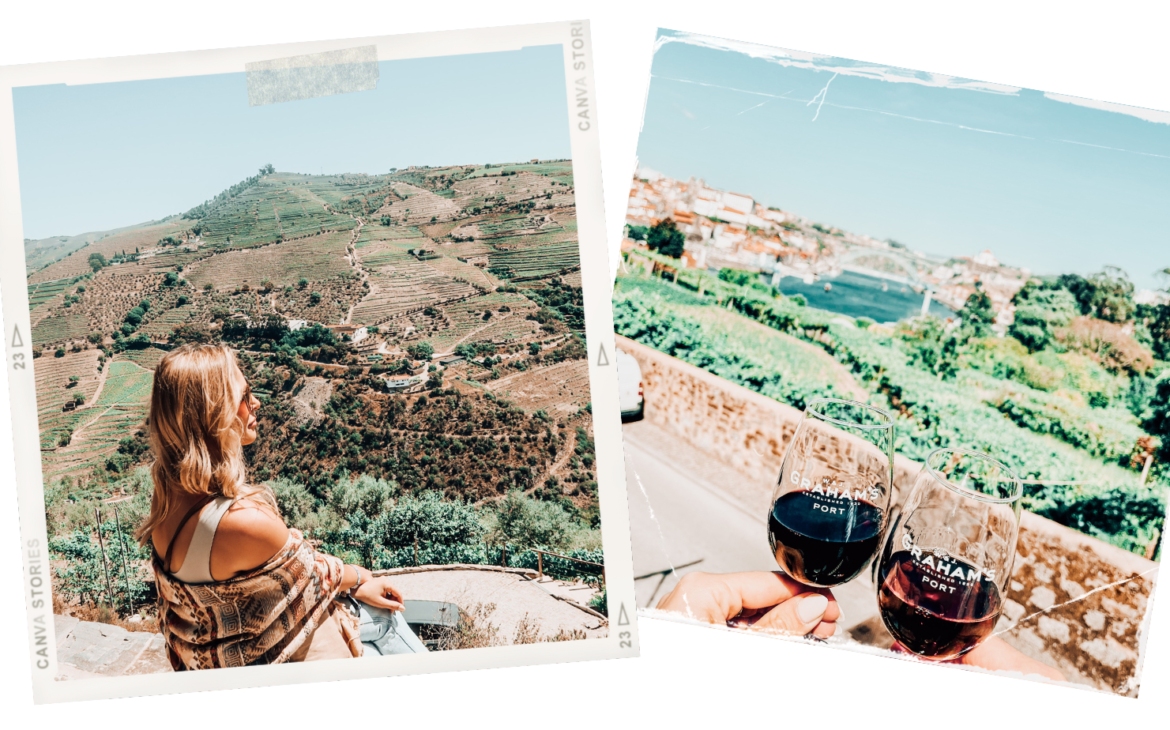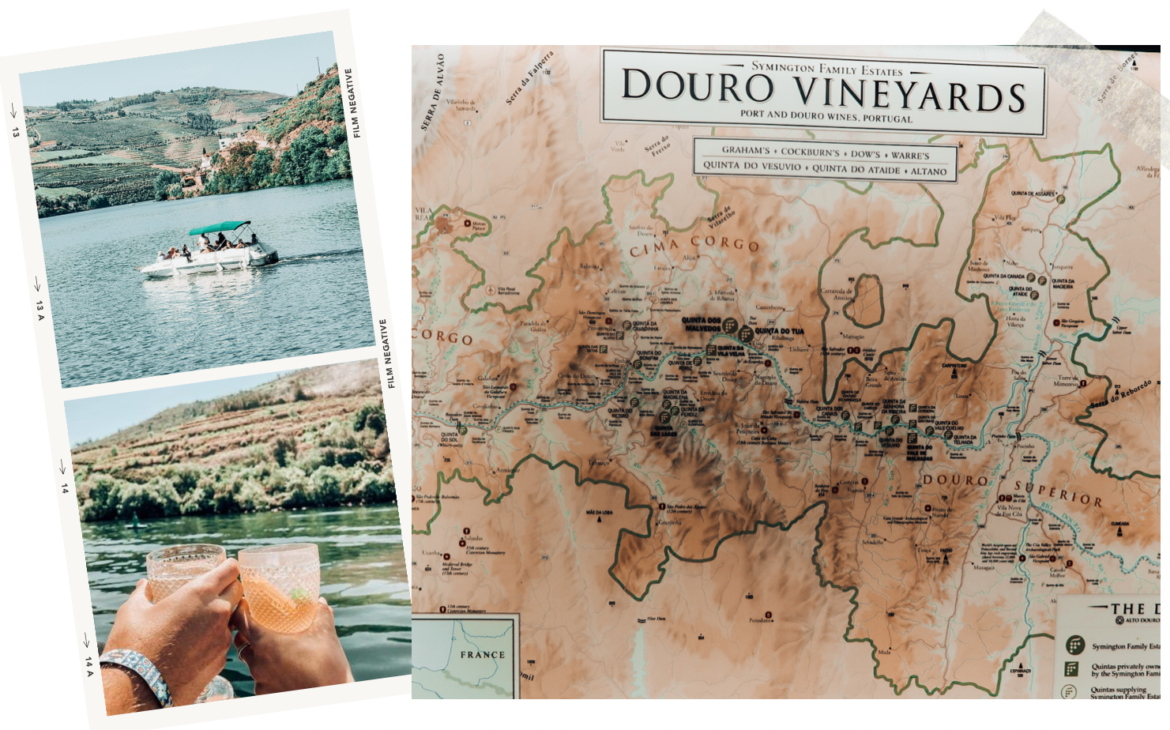Douro Valley
Travel Guide
Everything You Need to Know
Heading to Portugal soon? This Douro Valley travel breaks down all the details you need to know before visiting the home of Port wine!
Porto is the second largest city in Portugal and one of the most affordable places to visit in Western Europe. As a result, it has become a tourist hot spot and a must-not-miss European destination. But did you know that this is also the home of Port wine? The Douro Valley region is one of the best known wine regions in the world, dating all the way back to 1756! Thanks to the EU regulations about Protected Designation of Origin, this valley is the only place in the world that can legally produce what’s called Port wine – a true Portuguese delicacy. For decades this valley has offered the perfect climate and soil for cultivating grapes, as well as absolutely breathtaking scenery. In fact, the beautiful and dramatic landscape of the Douro Valley is so special it was awarded UNESCO World Heritage status in 2001! You can expect a gorgeous river surrounded by endless hills and steep terraces, all of which are covered in vineyards running down towards the river. This design allows the vines to have maximum exposure to the sun, while the river provides an easy route for transporting the wine that was made in the valley to where it would be stored and aged in the city of Porto. downriver. It is an absolutely spectacular sight to see.

Port Wine
What is Port?
Port, the most famous wine produced in all of the Porto and Douro wine regions, is a sweet, red, wine with flavors of raspberry, blackberry, caramel, cinnamon, and chocolate. It comes only from Portugal, and is usually consumed as a dessert wine, as it is rich, sweet, and quite strong! Unlike traditional wine, which undergoes fermentation in full, port is a fortified wine. During fermentation, brandy is added to port wine, thereby halting the process and preserving some of the sugars from the grapes. This is what gives port its signature sweetness, while also increasing the alcohol levels up 20% ABV. After fermentation, port traditionally stays in the Douro Valley for one winter after it’s made, as the cold temperatures encourage the wine and brandy to marry. It’s then transported by truck to the Port wine lodges in Porto, where the more humid, mild climate at sea level is ideal for aging (more on visiting the Port wine lodges below). The wines are then aged for a minimum of 2 years in a variety of large barrels, small oak barrels, and steal containers. The variation in the grapes, amount of years aged, and type of container it’s aged in results in a variety of Port wine styles, including including ruby, tawny, white, and rosé.

RUBY
Showing a simple, fruity, youthful character, Ruby Ports are generally the least expensive of the Port wines available on the shelf. They typically age in large oak casks for an average of two years, then are ready to drink as soon as they’re bottled. In a glass of Ruby Port, you will find complex aromas of red berries with notes of plum, cinnamon, and cherries. It is made with a blend of red grapes from a variety of vintages and served slightly chilled. Ruby Port will keep for several weeks after opening if it is stored in the fridge. In ascending order of quality, the types of Ruby Port are: Ruby, Ruby Reserva, Crusted, Late Bottled Vintage, Vintage Single Quinta and Vintage.
TAWNY
Tawny wine is made from the same grapes as Ruby, but matures in 600-liter wooden barrels for a minimum of seven years. Because of the oxidation, these complex and concentrated wines are lighter in color, with tones of brown and amber compared to their Ruby Port cousins. Their aroma is also more complex, with hints of nuts (walnut and almond) and wood (toast, coffee and chocolate). Most Tawny Ports have an age designation on the label: 10, 20, 30 or more years, which indicates the average year of the grapes in the bottle. These wines do not need to be decanted, they should be stored in the fridge, and they can easily last a month once opened due to the innate oxidation. Tawny wines, in ascending order of quality, are Tawny, Tawny Reserva, Tawny with age indication (10,20,30,40+) and Colheita, with Colheita being the only Tawny from a single vintage.
WHITE
Produced from indigenous grape varieties such as Rabigato, Viosinho, Gouveio, and Malvasia, this port is generally used as a base in cocktails, like the tonic & port. You can expect a golden / amber color, with aromas of apricot, roasted nuts and baked apples. This wine does not need to be decanted and is served slightly chilled.
ROSE
This innovative and vibrant style of Port has a distinctive pink hue and typically displays notes of cherry, raspberry, strawberry and caramel. While producing Rosé Port, juice has minimal skin contact, which gives Rosé color and fewer tannins to wines. The result is very aromatic, refreshing distinct wine, absolutely irresistible during hot summer days.
& BEYOND
Dessert wine not your thing? No problem! Long famous as the source of port wine, the Douro Valley is now also renowned for its fine, rich unfortified table wines, both red and white. There are upwards of 80 grape varieties used in the production of both port wine and table wines in the Douro Valley, and it’s not uncommon for the exact percentages in any given blend to go unknown, even by the winemaker. Of these, the most popular used for the production of red wines are Tinta Roriz, Touriga Francesca, Tinta Barroca, Touriga Nacional and Tinta Cao. In the production of Douro Valley white wines, the most commonly used grape varietals are Viosinho, Malvasia Fina, Gouveio and Rabigato.

Visiting The Douro Valley
Visiting the Douro Valley is about so much more than drinking wine – it gives you a first hand look at the complex production of Port, as well as the overall Port-focused culture! As soon as you see the vine-draped and ever-changing vineyard terrain, you’ll begin to appreciate just how much hard work it was (and still is) to produce traditional port wine. To this day, the production of port remains a labor of love, as grapes are still generally picked by hand and crushed the traditional way — by foot — since machines are unable to achieve high-quality results.
GETTING THERE
The best way to fully experience the Douro Valley is to either rent a car and spend a few days in the Douro Valley, or to embark on a full day Douro Valley tour. Unless you have a few days to fill, our recommendation is the full day tour out of Porto. The tour is probably the easiest route, as you won’t have to worry about transportation, which vineyards to visit, setting up a boat tour, making reservations, etc. We will break down all the details in our Douro Valley travel guide below!

What To Expect
HOW TO GET THERE
If you decide not to do a tour, you can travel from Porto to the Douro Valley via rental car, train, or even a boat. The drive from Porto is 45 to 60 minutes via car, 3 to 3.5 hours via train, and a scenic 7 hour boat ride. If you opt for the train or a boat, be sure to make a plan for transportation once in the Douro Valley. Finally, if you opt to go on a tour, transportation will be sorted for you.
WHEN IS THE BEST TIME TO VISIT?
The Douro Valley is a wonderful destination year round. But if we had to choose the best time to visit it would be during the fall, when the grapes are about to be harvested and the leaves are beginning to change color. If possible, try to plan your trip around the harvest time, as some places might even let you participate and stomp some grapes!
WHAT ABOUT BOATING THROUGH THE RIVER?
Separate from taking a boat to the Douro Valley, you can (and should) also take a boat ride! The Douro River runs right through the Douro Valley, and the vineyards just so happen to be planted all along the steep terrace hillsides surrounding the river. A boat ride is a fantastic way to enjoy the views surrounding you in the valley, and honestly, it remains one of our favorite Douro Valley memories. If staying in the area for a few days, you can book a boat tour in advance or, in some places, you can just walk down to the riverfront and get tickets for a boat trip. If you opt for a tour, almost all of them include an hour boat tour, as well as visits to 2 or more wineries, vineyard tours, lunch, and wine tasting.
WHAT ELSE SHOULD WE SEE IN DOURO VALLEY?
(If you take a tour, you can skip this section, as all of the planning will be done for you.) There isn’t just one spot in the Douro Valley that’s perfect to visit – there are dozens!. Some of the major towns to visit are Regua and Pinhao, which are about a 30 minute drive from each other. A few other top sights to check out include the Douro Museum in Regua, the town of Lamego and the Shrine of Nossa Senhora dos Remédios, the castle of Numão near Pocinho, and Vale do Coa Archaeological Park.

Our Recommendation
This Douro Valley travel guide would not be complete without a huge shout out to Manuel and his family, who host one heck of a Douro Valley tour! This AirBnB Experience, is above and beyond, and is probably our #1 Portugal recommendation. It includes round trip transportation from Porto, a river boat cruise (complete with a wine specialist, cocktails, and traditional Portuguese snacks), visits to 2 wineries, an exclusive chef lunch, and more. The guides are incredibly knowledgeable and strive to create a fun, social, relaxed experience, that is customized to each individual. If you are looking for an authentic experience, away from the commercialized wineries and tourist traps, this is the tour for you. You will even have the chance to get inside a port wine barrel to take photos!

Port Houses
Our Douro Valley travel guide would not be complete without mentioning the famous port wine lodges, the place the wine goes while its aging. These Port wine houses, located in Vila Nova de Gaia, offer a more humid, mild climate at sea level that is ideal for aging. Vila Nova de Gaia is situated across the Douro River from the city of Porto and is by far the most famous area of Portugal for the production of port wine. It is here that one can find the most renowned port cellars and warehouses that are open to visitors. The most popular of the port lodges to visit include Sandeman and Grahams Port.
Conclusion
Porto is an amazing vacation destination that is unmatched when it comes to the wine! Being one of the oldest wine regions in the world, and the only place in the world where Port wine is produced, this is a once in a lifetime opportunity. While drinking wine is one of our favorite activities, this experience is also about the culture, the history, the families behind the wine, and the breathtaking scenery of the Douro Valley.
We hope you have enjoyed our Douro Valley travel guide and are feeling inspired to try some Port wine! Don’t forget to head over to our full Porto travel guide for even more recommendations.


